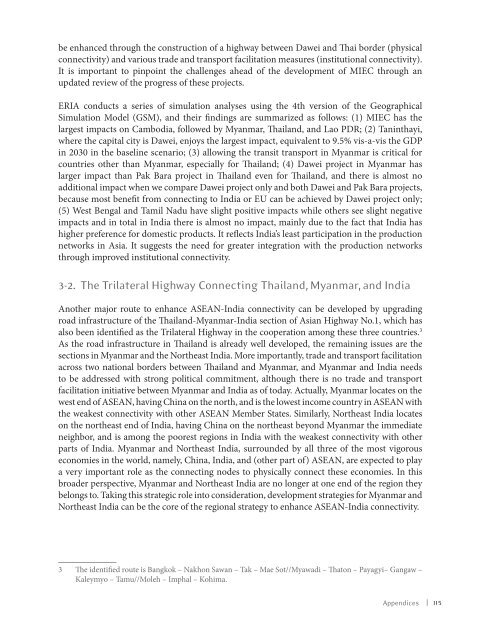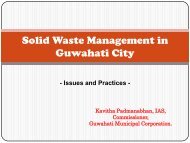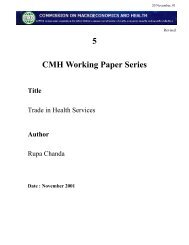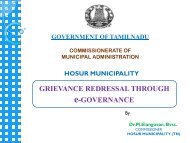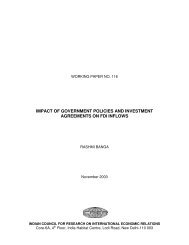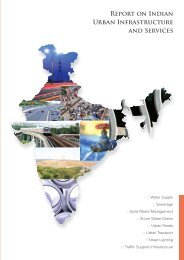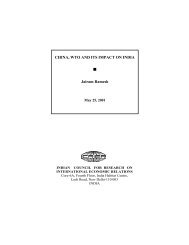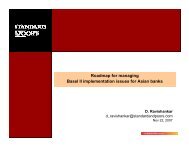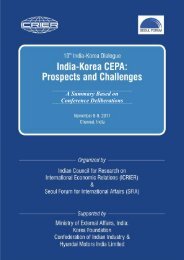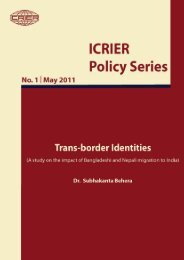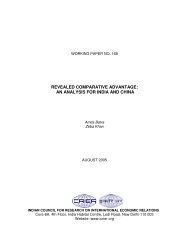Asia's Arc of Advantage - icrier
Asia's Arc of Advantage - icrier
Asia's Arc of Advantage - icrier
Create successful ePaper yourself
Turn your PDF publications into a flip-book with our unique Google optimized e-Paper software.
e enhanced through the construction <strong>of</strong> a highway between Dawei and Thai border (physical<br />
connectivity) and various trade and transport facilitation measures (institutional connectivity).<br />
It is important to pinpoint the challenges ahead <strong>of</strong> the development <strong>of</strong> MIEC through an<br />
updated review <strong>of</strong> the progress <strong>of</strong> these projects.<br />
ERIA conducts a series <strong>of</strong> simulation analyses using the 4th version <strong>of</strong> the Geographical<br />
Simulation Model (GSM), and their findings are summarized as follows: (1) MIEC has the<br />
largest impacts on Cambodia, followed by Myanmar, Thailand, and Lao PDR; (2) Taninthayi,<br />
where the capital city is Dawei, enjoys the largest impact, equivalent to 9.5% vis-a-vis the GDP<br />
in 2030 in the baseline scenario; (3) allowing the transit transport in Myanmar is critical for<br />
countries other than Myanmar, especially for Thailand; (4) Dawei project in Myanmar has<br />
larger impact than Pak Bara project in Thailand even for Thailand, and there is almost no<br />
additional impact when we compare Dawei project only and both Dawei and Pak Bara projects,<br />
because most benefit from connecting to India or EU can be achieved by Dawei project only;<br />
(5) West Bengal and Tamil Nadu have slight positive impacts while others see slight negative<br />
impacts and in total in India there is almost no impact, mainly due to the fact that India has<br />
higher preference for domestic products. It reflects India’s least participation in the production<br />
networks in Asia. It suggests the need for greater integration with the production networks<br />
through improved institutional connectivity.<br />
3-2. The Trilateral Highway Connecting Thailand, Myanmar, and India<br />
Another major route to enhance ASEAN-India connectivity can be developed by upgrading<br />
road infrastructure <strong>of</strong> the Thailand-Myanmar-India section <strong>of</strong> Asian Highway No.1, which has<br />
also been identified as the Trilateral Highway in the cooperation among these three countries. 3<br />
As the road infrastructure in Thailand is already well developed, the remaining issues are the<br />
sections in Myanmar and the Northeast India. More importantly, trade and transport facilitation<br />
across two national borders between Thailand and Myanmar, and Myanmar and India needs<br />
to be addressed with strong political commitment, although there is no trade and transport<br />
facilitation initiative between Myanmar and India as <strong>of</strong> today. Actually, Myanmar locates on the<br />
west end <strong>of</strong> ASEAN, having China on the north, and is the lowest income country in ASEAN with<br />
the weakest connectivity with other ASEAN Member States. Similarly, Northeast India locates<br />
on the northeast end <strong>of</strong> India, having China on the northeast beyond Myanmar the immediate<br />
neighbor, and is among the poorest regions in India with the weakest connectivity with other<br />
parts <strong>of</strong> India. Myanmar and Northeast India, surrounded by all three <strong>of</strong> the most vigorous<br />
economies in the world, namely, China, India, and (other part <strong>of</strong>) ASEAN, are expected to play<br />
a very important role as the connecting nodes to physically connect these economies. In this<br />
broader perspective, Myanmar and Northeast India are no longer at one end <strong>of</strong> the region they<br />
belongs to. Taking this strategic role into consideration, development strategies for Myanmar and<br />
Northeast India can be the core <strong>of</strong> the regional strategy to enhance ASEAN-India connectivity.<br />
3 The identified route is Bangkok – Nakhon Sawan – Tak – Mae Sot//Myawadi – Thaton – Payagyi– Gangaw –<br />
Kaleymyo – Tamu//Moleh – Imphal – Kohima.<br />
Appendices<br />
| 115


